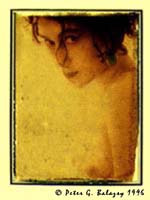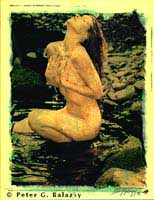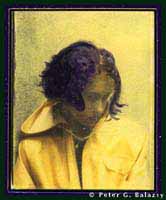The History:
Few new artistic
methods have generated as much curiosity,
interest and excitement as the
"Water-graph" technique (or
Polacolor Transfer). Fuji Film makes a similar
self developing film that is also used by
Peter Balazsy to produce yet another
variation in image transfer. (Peter Balazsy pioneered and developed the first-ever successful methods for the Fuji image-transfer process in 1992)
 The subtle colors and fresco texturings
you may see in certain renderings show
how transfers are unlike any other
photographic process.
The subtle colors and fresco texturings
you may see in certain renderings show
how transfers are unlike any other
photographic process. Artists and photographers alike
have now begun expressing themselves
through this intriguing new medium.
The actual transfer
concept was discovered quite by accident
in the mid sixties when a Polaroid lab
photographer placed a Polacolor negative
face down on a counter top and later
found a partial image was transferred to
the surface of the counter. Experiments
with the process were discouraged on an
official research level but, over the
years, experimenters have dabbled and
developed interesting variations on the
transfer process theme.
 The process is
capable of producing both fully rendered
images with a beautiful softness, as
well as partially rendered images
reminiscent of ancient frescoes. Image
reworking ranges from soft accentuation
of color to bold combinations of
photography and painting. The process is
capable of producing both fully rendered
images with a beautiful softness, as
well as partially rendered images
reminiscent of ancient frescoes. Image
reworking ranges from soft accentuation
of color to bold combinations of
photography and painting.
The Basic Process
In brief, image
transfer is the process of peeling apart
a self developing film packet and
transferring the positive onto a
non-photographic surface. 
The artist can work "live" by
shooting his subject with a Polaroid
camera and then transfer the image on the
spot or by shooting with 35mm, or similar
standard photographic slides and copying
the slide to Polaroid for transferring
images at a more convenient time, thus
allowing further variations in exposure
and filtering, as well as choosing
different receptor materials with
infinite combinations producing
completely unique "one of a
kind" prints.
The Artistic Process

These "original" works of art
are produced through many stages of
creative and technically sophisticated
steps.
Step 1.) The creative process of
selecting subject matter and then
composition and all the technical aspects
of creating a quality photograph.
Step 2.) The image is projected to
Polacolor film using many combinations of
filters and exposures.
Step 3.) The developing process is
interrupted prematurely at the creative
whim or discretion of the artist to
produce further image subtleties.
Step 4.) The receptor material must be
selected and prepared. Typically the
receptor sheet is a type of high grade
water color or print making paper that
may be prepared using water or some other
additives such as wetting agents or
fixers etc.
Step 5.) The Polacolor negative image is
placed in contact with the receptor sheet
(paper, silk, wood etc.) again
introducing a broad range of techniques
usually rolling with a cylinder or spoon
etc.
Step 6.) Draws again on the artist's
creativity. At this stage the image may
lead the artist to add color of his own
by painting in with inks, pencil, pastels
or watercolors. 
Again the artist may choose to peel or
scratch the image surface adding
additional texture.
Washing or rubbing certain areas of the
image creates a special feel or look.
Another step of optionally rubbing on
gold leaf or laminating with various
materials is sometimes employed.
The final result can be
a somewhat unpredictable and delightful
surprise. 
The particular variations established by
each artist and the continuity of results
obtained is an expression of the talent
of the individual Photo-Artist.
All of the various
stages and processes that lead to
producing the final image will assure you
that the "WaterGraph" you own
is truly unique.
You may
see another interpretation of the
original subject image, but no two
"WaterGraph" transfers could
ever really be identical.
~~~~
Images
© Peter G. Balazsy
~Studio located in Northern NJ ~
~ (973) 790-7960 ~
|